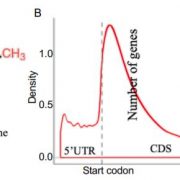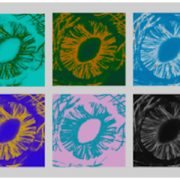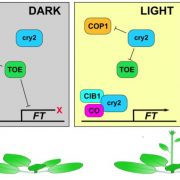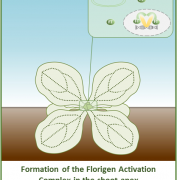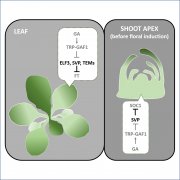Two ABA-responsive transcription factors reset the requirement for vernalization by re-activating FLOWERING LOCUS C in embryos
Xu et al. identify two transcription factors that activate FLOWERING LOCUS C during embryogenesis, thus re-setting the requirement for vernalization. https://doi.org/10.1093/plcell/koac077
By Guokai Xu, Zeng Tao and Yuehui He
Peking University Institute of Advanced Agricultural Sciences
Peking-Tsinghua Center for Life Sciences, School of Advanced Agriculture Sciences, Peking University
Chinese Academy of Sciences Center for Excellence in Molecular Plant Sciences
Background: Many overwintering plants grown in temperate regions become competent to flower in the spring only after experiencing prolonged cold in the winter, through a physiological process known as vernalization. In the model flowering plant Arabidopsis thaliana, prolonged cold exposure results in chromatin-mediated repression of the potent floral repressor FLOWERING LOCUS C (FLC) by Polycomb group (PcG) proteins. The cold-induced Polycomb-repressed chromatin state at FLC is maintained after the plants return to warm conditions, leading to stable FLC repression and the epigenetic ‘memory of winter cold’, enabling plants to flower. After flowering, the Polycomb-repressed chromatin state at FLC is transmitted to early embryos through the egg cell but is reset during embryo development to ensure that each generation of plants must experience winter cold to acquire competence to flower in spring. Hence, embryonic re-activation of FLC expression during seed development is essential to confer the over-wintering growth habit to each generation of Arabidopsis.
Question: What regulatory genes underlie embryonic FLC reactivation following parental vernalization (prolonged cold exposure)?
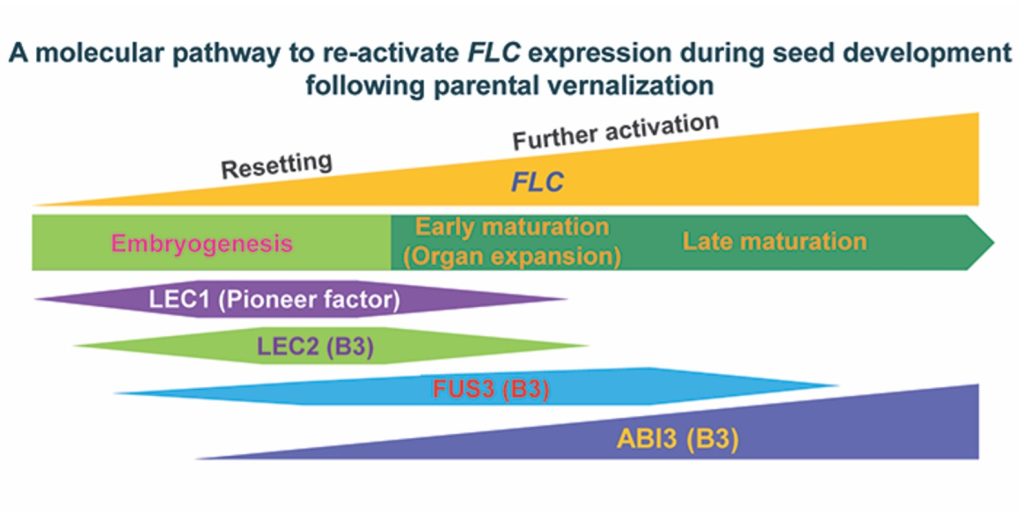 Findings: We found that embryonic FLC reactivation during seed development occurs in two phases: resetting of cold-induced FLC silencing during embryogenesis and further FLC activation during embryo maturation. We further show that the transcription factor ABSCISIC ACID-INSENSITIVE 3 (ABI3) mediates embryonic FLC reactivation from late embryo development through embryo maturation. ABI3 recruits a scaffold protein that engages chromatin modifiers to deposit covalent chromatin modifications on FLC chromatin, and these modifications promote FLC expression, resulting in an active FLC chromatin state. In addition, the abscisic acid-responsive transcription factor ABI5 functions together with ABI3 to promote FLC reactivation in response to an increase in abscisic acid levels that occurs during embryo maturation. These two transcription factors (TFs), together with the previously identified TFs LEAFY COTYLEDON 1 (LEC1, a pioneer TF component) and two B3 domain TFs LEC2 and FUSCA3, form a molecular pathway that mediates embryonic FLC reactivation during seed development, following parental vernalization.
Findings: We found that embryonic FLC reactivation during seed development occurs in two phases: resetting of cold-induced FLC silencing during embryogenesis and further FLC activation during embryo maturation. We further show that the transcription factor ABSCISIC ACID-INSENSITIVE 3 (ABI3) mediates embryonic FLC reactivation from late embryo development through embryo maturation. ABI3 recruits a scaffold protein that engages chromatin modifiers to deposit covalent chromatin modifications on FLC chromatin, and these modifications promote FLC expression, resulting in an active FLC chromatin state. In addition, the abscisic acid-responsive transcription factor ABI5 functions together with ABI3 to promote FLC reactivation in response to an increase in abscisic acid levels that occurs during embryo maturation. These two transcription factors (TFs), together with the previously identified TFs LEAFY COTYLEDON 1 (LEC1, a pioneer TF component) and two B3 domain TFs LEC2 and FUSCA3, form a molecular pathway that mediates embryonic FLC reactivation during seed development, following parental vernalization.
Next steps: We are interested to explore how the highly activated FLC expression state (active chromatin state) in the embryo is transmitted to the seedling and how this active state is maintained in vegetative growth and development.
Reference:
Guokai Xu, Zeng Tao, and Yuehui He (2022) Embryonic reactivation of FLOWERING LOCUS C by ABSCISIC ACID-INSENSITIVE 3 establishes the vernalization requirement in each Arabidopsis generation. https://doi.org/10.1093/plcell/koac077


